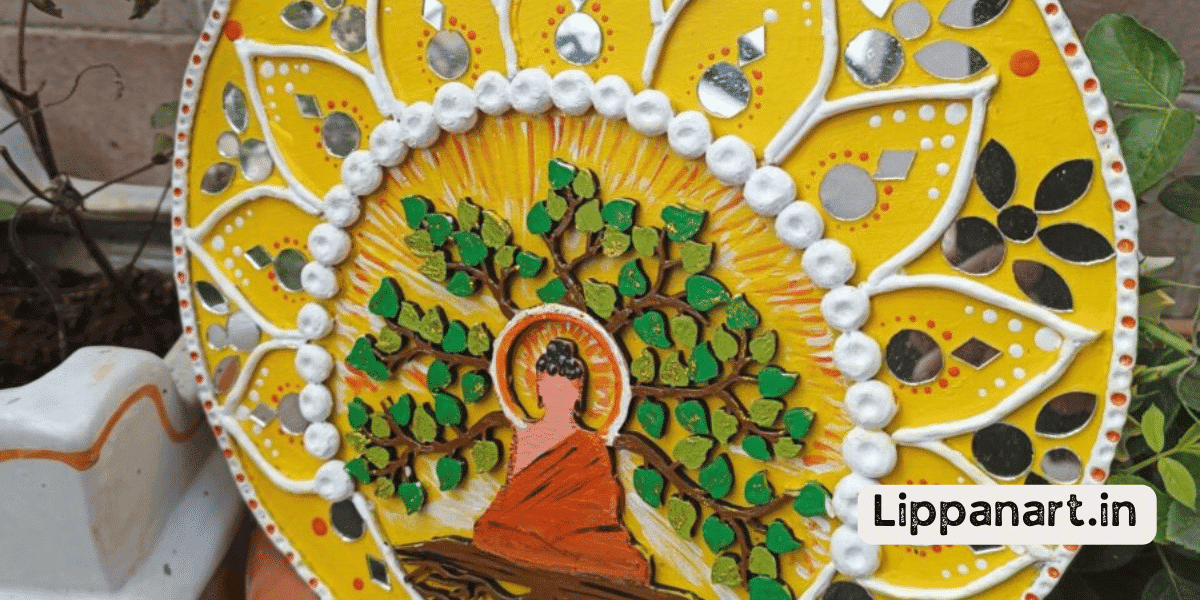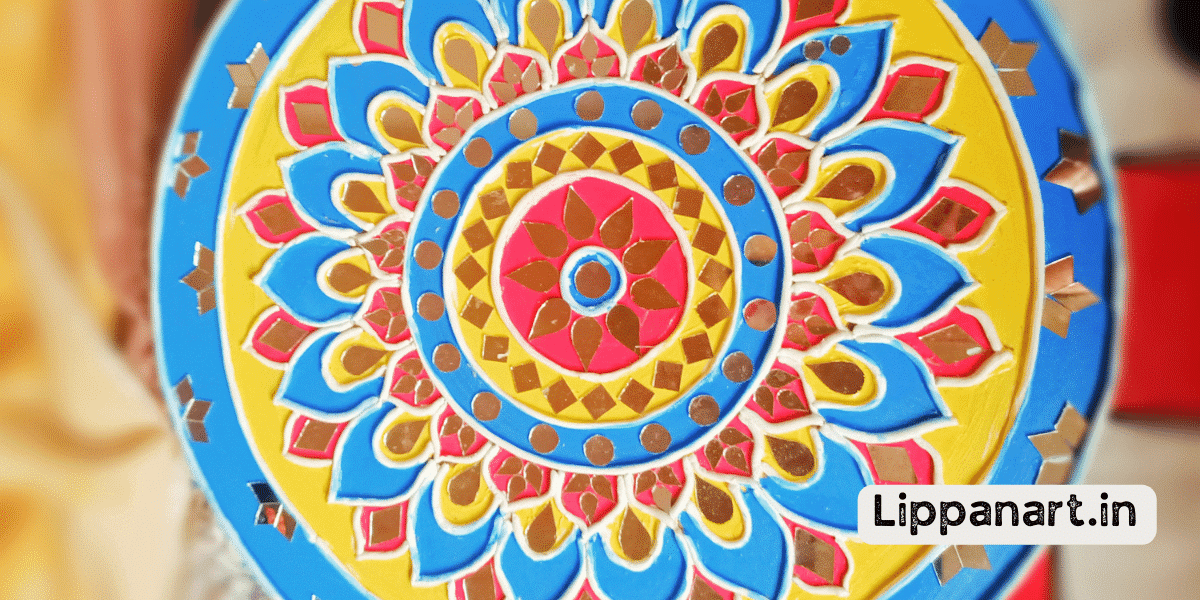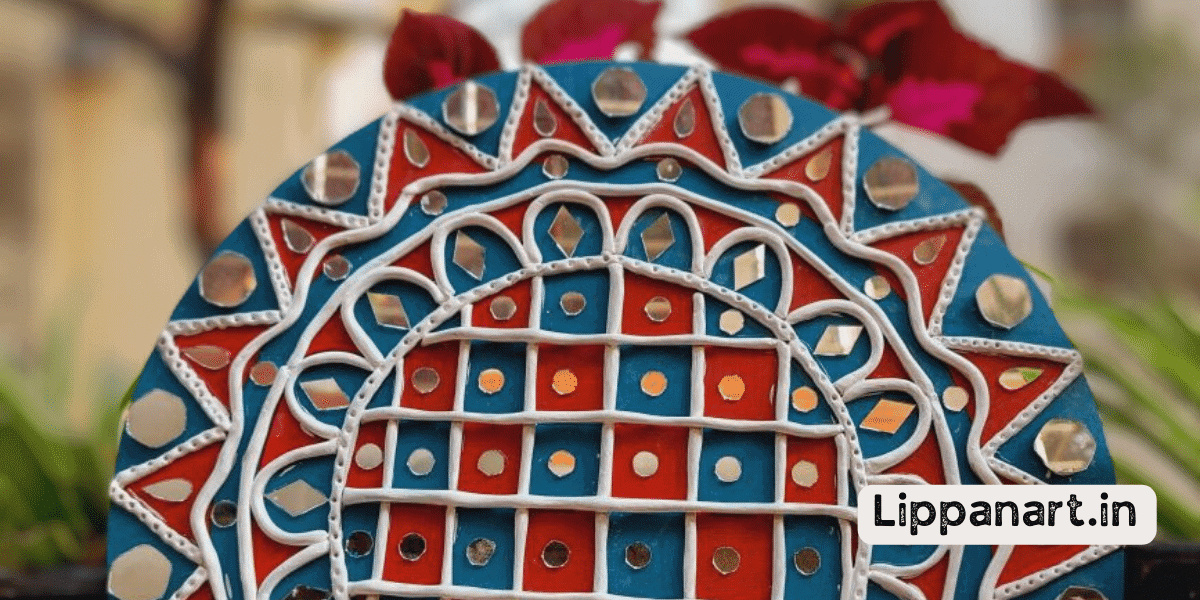Let your creativity shine with the ancient art of lippan! Combining traditional techniques with modern materials can bring a unique sparkle to your home decor.
With the right supplies and a little know-how, you can produce stunning works of art that will wow your friends and family.
In this guide, you’ll find everything you need to start your lippan journey, from clay mixtures to sealants and protective gear.
Let’s make something beautiful together!
Essential Clay Mixture Components
Clay mixtures typically contain essential components such as clay powder, binders, and filler materials.
To begin lippan art, you’ll need a mixture of clay powder, white acrylic paint, and a binding agent. The clay powder is the most important component of the mixture as it gives the final artwork its unique look and texture.
Binders help hold the clay together and can be anything from vegetable gum to acrylic medium. Fillers add bulk and strength to the mixture, including sawdust, sand, and even crushed glass.
Lastly, you’ll need a few tools, such as knives and other shaping tools, to create the desired shapes and designs.
With the right combination of materials and tools, you can create amazing art pieces with lippan. Start experimenting to find the perfect combination and create something unique.
Adding Sparkle: Mirrors and Decorative Elements
Adding sparkle to lippan art projects is easy with mirrors and other decorative elements! You can use acrylic mirrors to create intricate designs that reflect light or add a reflective layer to any piece.
Palette knives can break the mirrors into smaller pieces to add a unique texture to your work. You can also think outside the box and use other materials, such as glass beads or glitter, to add a shimmering finish. The inch thickness of the plate also plays a key role in creating a reflective effect.
Here are four tips to help you create mesmerizing pieces:
- Choose mirrors with a higher reflective quality
- Use palette knives to break the mirrors into smaller pieces
- Think outside the box and use other materials to add sparkle
- Consider the inch thickness of the plate for added reflective effect.
These tips allow you to add sparkle and shine to your lippan art projects. Experiment with different materials and techniques to bring your art to life and create something uniquely yours.
Infusing Colors: Pigments and Natural Dyes
Infusing colours into your lippan art projects is easy with pigments and natural dyes!
Pigments provide a wide range of colours that can be used to create vivid, beautiful designs. Natural dyes are also available and provide a more earthy, subtle look that can bring a unique character to your piece of art.
Combining both types of colours can create unique, eye-catching geometric patterns. Acrylic paint is an ideal medium for lippan art projects, as it is easy to work with, dries quickly, and is durable.
You can purchase natural dyes and pigments in various colours and sizes to get started. Experimenting with colour combinations and different techniques can yield a beautiful, unique piece of art.
You can create stunning art pieces with creativity that will make an impression. Whether you’re a beginner or an experienced artist, incorporating pigments and natural dyes into your lippan art projects is a great way to add colour and life to your work.
Shaping and Design Tools for Artistic Expression
Using the right tools for shaping and designing lippan art can help you express yourself in new and exciting ways. First, you must create the clay mixture that will become the base of the lippan art. It combines clay, sand, and powdered cow dung with water to form clay. Once this is completed, you can start the creative process with various tools.
Here are four must-haves for expressing yourself through lippan art:
- Rolling Pin: A rolling pin must create a smooth, even surface on the clay.
- Punch: A punch is a pointed tool for making circular designs in clay.
- Wire Cutter: A wire cutter cuts patterns, borders, and other shapes into clay.
- Spatula: A spatula is used to carve intricate details into the clay.
Creating lippan art is a great way to express yourself and bring your ideas to life. When equipped with the proper tools, you can produce stunning and distinctive works of art that embody your ingenuity and imagination. Feel free to experiment with different shapes, designs, and techniques to find what works best for you.
- Editor’s Choice
- Best Seller
- Amazon Choice
Preserving Your Masterpiece: Sealants and Varnishes
Once you’ve finished your masterpiece, you must protect it with sealants and varnishes. Sealants and varnishes are especially important for acrylic painting since they provide a protective layer that keeps the colours from bleeding and fading.
You’ll need to pick the right glue choice for your project to ensure your art lasts. To get the best results, carefully read the instructions and directions with the sealant or varnish. Ensure that the adhesive you choose suits the materials you utilized in producing your artwork. Once you’ve chosen the right sealant or varnish, apply it lightly and evenly, and let it dry according to the instructions.
If you need help with the best glue choice for your project, speak to an experienced artist or consult an art materials supplier. They’ll be able to suggest the best sealants and varnishes for your masterpiece and give you helpful tips and tricks for protecting your art.
No matter what art you create, sealants and varnishes protect your masterpiece and keep it looking beautiful for years. With the right glue choice and careful application, you can ensure that your art stays vibrant and beautiful for generations.
Choosing the Right Surface for Lippan Art
When it comes to Lippan art, choosing the right surface is key to creating a beautiful piece. The surface should be flat and free from any blemishes. It should also be large enough to accommodate the size of your design.
Here are four tips to help you choose the right surface for your Lippan art:
- Consider a glu unit, a plastic plate of a desired size that can be used to make a stable surface to work on.
- If you plan to hang your artwork, mount it on a wooden board the same size as your design.
- A thick cardboard or foam board would be a good option if you are working with a heavy material such as clay.
- For a more traditional approach, you can use a canvas or mural board with a flat, rigid surface that will help create a vibrant work of art.
No matter what surface you choose, make sure it is sturdy enough to hold the weight of your artwork. Additionally, consider the size, texture, and weight of the material you are working with before choosing. You can easily turn your vision into a masterpiece with the right surface.
Ensuring Safety: Protective Gear and Precautions
Now that you’ve chosen the perfect surface for your lippan art, the next step is to ensure your safety.
To safeguard your skin and lungs from the clay dust, it is recommended that you wear protective gear like a mask and gloves. Also, take precautions to keep your work area clean and dust-free.
Make sure your work area is well-ventilated, and avoid inhaling the dust. To protect your eyes from clay or dust particles, it’s advisable to wear glasses or goggles. When using tools like wire cutters, ensure they are in good condition and use them carefully.
Mixing and Managing: Water and Containers
Mixing the clay and water requires the right containers and ratios to create the perfect lippan art. To master this skill, you’ll need to pick up some essential materials. Here’s a list of must-haves for managing and mixing water and clay:
- Acrylic containers with sufficient depth
- Water containers with spouts
- A measuring cup
- A sponge
Having these items on hand will help ensure that you can accurately and safely measure and mix water and clay while you work. Acrylic containers make storing, measuring, and mixing your ingredients easy. A water container with a spout is useful for controlling the amount of water you’re adding to the clay. A measuring cup is a helpful tool for accurately measuring the appropriate amounts of clay and water required. Finally, a sponge is essential for cleaning up any messes you might make.
Textures and Techniques: Cloth and Fabric
To create unique and interesting textures on your lippan art, you’ll need to know how to work with cloth and fabric. Using fabric and cloth adds dimension and texture to your artwork. You can use a variety of fabrics like linen, cotton, and silk. You’ll also need to use painting knives to help spread the fabric into different shapes and designs.
| Type of Fabric | Texture | Uses |
|---|---|---|
| Linen | Rough | Embellishment |
| Cotton | Soft | Background design |
| Silk | Smooth | Detailing |
You should always use a base fabric first, then add layers of different fabrics for a more intricate design. You can also use fabric to create a collage-like effect. Additionally, you can also use fabric to make geometric designs. Experiment with different fabric shapes and layering techniques to create unique and innovative designs.
- Editor’s Choice
- Best Seller
- Amazon Choice
Keeping it Neat: Cleaning Supplies for Lippan Art
Keeping your workspace clean while creating lippan art is a must. You’ll need essential cleaning supplies to ensure everything looks neat and tidy. Here are some must-haves to keep your art looking its best:
- Gentle cleaning materials – Use a soft, lint-free cloth to clean away any accumulated dust or debris on your artwork.
- Cotton swabs are great for getting into small crevices and corners to remove any dirt or grime that has built up.
- Soft brush – A soft brush is great for cleaning away any excess glue or paint without damaging the lippan art.
- Vacuum – If you need to get into hard-to-reach places, a vacuum cleaner can suck up dust or dirt.
These items will help you keep your lippan art clean and looking its best. Using appropriate cleaning supplies makes it possible to effortlessly preserve the aesthetic appeal of your artwork.
Frequently Asked Questions
What Is the Best Type of Clay to Use for Lippan Art?
The best clay to use for lippan art is one that’s lightweight yet strong and easy to mould. It should also be water-resistant and able to hold its shape. Try out a few different types to find the one that best fits your needs and preferences.
Are There Any Special Safety Considerations to Keep in Mind While Working With Lippan Art Materials?
When creating with lippan art materials, safety is key! To prevent inhaling dust, working in a well-ventilated area while wearing protective eyewear and gloves is recommended. Use non-flammable materials and always keep a fire extinguisher nearby. Make sure to clean up any messes when you’re done to ensure safety for yourself and others.
How Do I Choose the Right Surface for My Lippan Art Project?
Choose a surface that suits your project’s needs. Think about the texture, size, and durability you need. Consider if you want a flat or curved area. Experiment with different materials to find the perfect fit!
What Kind of Sealants and Varnishes Should I Use to Preserve My Lippan Art Masterpiece?
You’re after a masterpiece, huh? Try a sealant or varnish designed for outdoor use for a truly timeless piece. These are reliable, durable, and waterproof. Plus, they add a nice glossy finish that’ll make your art pop!
How Should You Clean Your Lippan Art Supplies?
To clean your lippan art supplies, gently wipe them down with a soft, damp cloth. Use mild soap and lukewarm water, avoiding harsh cleaners and scrubbing too hard.
Conclusion
You’ve now got the basics of lippan art down, and with a little practice, you can become an expert!
The average lippan art piece takes around 10 hours to complete, so be encouraged if it comes together slowly.
By utilizing the proper materials, tools, and techniques, one can craft magnificent pieces of art that will endure for a lifetime.
So, grab your supplies and get to work!












